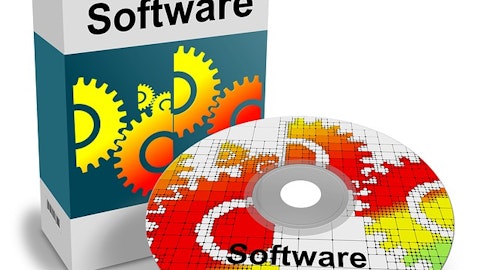It provides us with additional landing points and starting points for new customers, and, you know, continues to just add more differentiated value for Braze over time, which obviously encourages stickiness and growth. I think also, you know, one of the things that I come back to, when I think about our future growth is that Braze still is right around 2,000 customers today even as we’re at 500 million in car. And so, as we expand to billion in ARR, we’ll expect to be somewhere around 4000 to 5000 customers. And, as we continue to grow from there, you know, we’re preparing as an organization for, having orders of magnitude more than that. And so as we look at upgrading our own internal processes, right now, every time we, look at whether it’s a new post sales motion, a new way that we’re continuing to add automation to things like product led sales or product led growth motions, etcetera, those are all investments that we’re making to prepare for A meaningful scale differences as we continue to grow.
For Braze to achieve our community goals, we obviously need to have, you know, a much larger reach, but we think that’s also a motion they will compound on itself. Speaking of that, there’s also obviously the agencies and the ecosystem, and the partnership side, which also will help to compound our way to a billion in ARR, and beyond. And so, you’re seeing investment across a lot of different dimensions for Braze to be able to support that. We feel, you know, really good about the very diverse customer base that we have today. You hear me talk about that all the time, Braze is very much not a business that went and so, like, highly penetrated and concentrated itself into, a specific vertical or a specific channel or a specific geo. We have a very diverse foundation upon which, continue to build, a very, very large business and build into a very large opportunity.
It’s obviously more challenging to start building a business that way than it is to start in a niche and be able to kind of build directly into it. But we also see it as being less risky as we look out to, you know, big bigger numbers and kind of more long term targets because, we’ve already proven that we can sell into those verticals, that we can satisfy those use cases, that can deliver, a product to companies of those sizes and that we can solve, not just, regional and local use cases around the world, but also the unique nature of global businesses as well.
Scott Berg: Excellent. Thank you.
Operator: Our next question comes from Brian Schwartz with Oppenheimer. Please unmute yourself and ask your question.
Brian Schwartz: Yeah. Thank you for taking my question, great quarter. Bill, the commentary that that you’ve been giving around the call about what you’re seeing with the macro, I’m wondering if that is, you’re saying a similar environment all around the world, specifically, you know, in EMEA and APAC in North America. Are there any differences? Or is there any, stability or maybe somewhat improvement in any of the international markets? Thanks.
Bill Magnuson: You know, no. We’re not seeing any sort of, you know, meaningful improvement. I think everybody’s kind of suffering under the same high interest rate environment, the same volatility, the same drive toward efficiency overgrowth, the same, you know, inflationary environments. I would say that, you know, we also we saw different timing in terms of, some of the venture world just because a lot of the companies in the United States were had very recently raised large amounts of money and so, their runways weren’t coming up on them quite as quickly. So we are actually, to some extent, anticipating that could become more of a problem in the venture backed world in the Americas and EMEA, coming into next year as some of those runway start to run out.
And I think we’ve already been seeing that in APAC over the last year where a lot of those startup businesses were, a little bit less well capitalized heading into this environment. And so that part of it, I would say, is uneven, but it’s more like uneven timing on badness. All that said, we are also expecting the recovery, and eventual loosening of conditions to similarly be uneven. We’re certainly seeing, different Responses from governments and different currency performance and different paces of progress in terms of inflation, stabilization, and different markets around the world. And so for us, what that adds up to is that, we need to continue to be really paying close attention to data, to evolving conditions and making sure that we’re deploying, sales capacity and marketing investments in the places where we start to see early signs of recovery.
Because, well, I think we’re seeing similarly subdued negative macro conditions all around the world right now. The eventual recovery to be uneven, and we want to make sure that we’re quick to those markets that are, that are early to it.
Brian Schwartz: Thank you.
Operator: Our next question comes from D.J. Hynes with Canaccord. Please unmute yourself and ask your question.
D.J. Hynes: Hey. Thank you, guys. So, Bill, we’ve seen some other marketing or CDP companies recently initiate or talk about rolling out, you know, a mobile channel to complement their existing email, SMS, other activation channels. You guys obviously went the other way, right, starting in mobile and then initiating other channels. Can you just speak to the benefit or challenges of going one way versus the other. Do you think there’s a material difference? I’d love to hear your take.
Bill Magnuson: Yeah. So I’d first correct history a little bit, and note that we actually started across four separate channels, and the very first version of our product that we launched included email. And so, you know, Braze dating all the way back to our beta release in 2012, has been building on mobile and email as well as in product messaging, which included both a persistent in product message type through our news feed as well as a slide up message, that was interactive with the customer. And so our first version launched with four different channels, which included some that were pushed by their nature, some that were pulled by their nature, that was integrated into a product and email obviously being outside of the product.
And the pressures that having that multidimensional channel set place on the segmentation and the orchestration and the personalization capabilities, as well as the nature of being able to maintain the invariant of keeping everything interactive in real time across all those different, channel types meant that, it’s definitely harder for us to build in the early days because every time we rolled out a new targeting feature, we had to make sure it works across all those different channels. But now we find ourselves in a position where as we’ve gone from 4 to 5 to 6, dozen or more channels depending on how you want to count them, that our foundations anticipated all those different dimensions that message types would have. And so I think when you compare that then to, a lot of our competitors that, they either started in a single channel or they started channels that were not integrated into the products.




